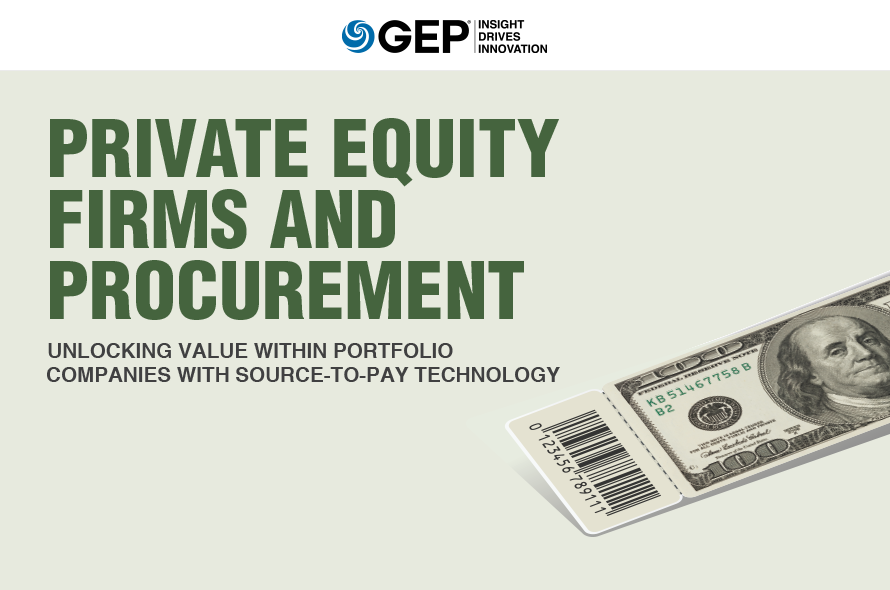For Private Equity (PE) firms and their investors, maximizing return on investment (ROI) from portfolio companies is a key goal. Clearly, optimizing spend and improving profitability are top priorities.
This is where procurement comes into play. With unified source-to-pay (S2P) technology, PE firms can unlock significant value from portfolio companies.
A new white paper — Private Equity Firms and Procurement: Unlocking Value Within Portfolio Companies With Source-To-Pay Technology — explains how procurement teams can boost operational efficiency and generate significant cost savings for the enterprise with unified S2P technology. The paper also explores key functions of an S2P platform and the benefits of a unified approach.
It’s an essential read for business and finance leaders at PE firms.
The last few years have seen a spurt in investments by private equity (PE) firms, thanks largely to a favorable investment climate in the United States. Increased capital availability and fewer high-yielding alternative investments have led to this frenzy of activity, which has resulted in sky-high valuations.
PE firms are now trying to do what they do best — improve the performance of the acquired firms. Portfolio teams are changing the ways they evaluate, and drive change in, operational aspects of acquired companies — the portfolio teams’ involvement is deeper, and for longer durations (increased exit horizons). This change is the result of high valuation at acquisition. Growth and cost reduction are the two ultimate means to increasing value in portfolio companies.
Procurement has emerged as an area from which significant value can be unlocked through not only cost reduction and cost avoidance, but also by driving top-line growth through supplier-driven innovation. Depending on the maturity of the portfolio company’s procurement organization, PE firms can benefit beyond cost savings by consistently implementing best-in- class procurement practices and leveraging the supply base to create strategic synergies, both within the company and across the portfolio. Leveraging a source-to-pay (S2P) technology platform across a PE firm’s portfolio companies is an innovative way to:

- Identify concrete savings opportunities in and across portfolio companies, and more accurately “size the prize” relative to effort — thus aiding in the prioritization of sourcing projects.
- Execute complex sourcing projects for individual companies, and across the portfolio to leverage combined spend.
- Maintain a central contract repository and facilitate collaboration across multiple stakeholders in drafting contracts.
- Implement robust supplier management programs that are consistently executed across all portfolio companies, in line with best-in-class practices.
UNDERSTANDING SOURCE-TO-PAY TECHNOLOGY
Let’s take a look at the various components, or functions, of a Source-to-Pay (S2P) platform and how each of these functions can help PE firms capture value for their portfolio companies. We will touch upon 5 core functions – Spend Management, Sourcing (eRFx), Project Management, Contracting, and Supplier Management.
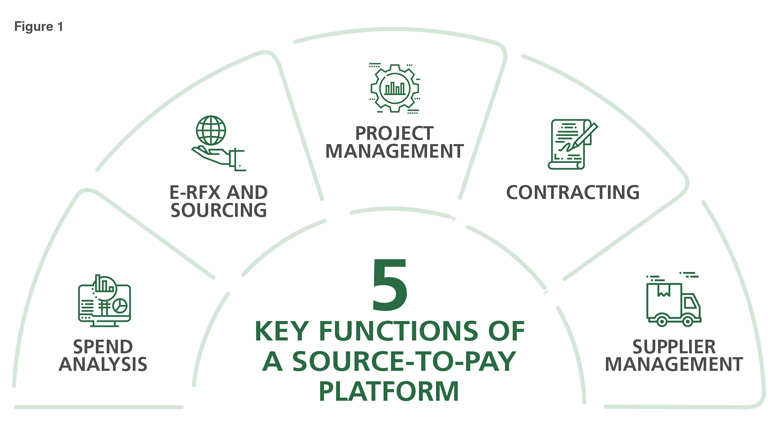
The most effective way to capture maximum value and benefits is to integrate the above functions as part of a unified S2P platform. However, customizability as per situational vagaries (technological readiness of the acquired company, appetite for change, exit horizon, etc.) is key — these functions need not all be implemented in all portfolio companies. Rather, they should be deployed where the potential return justifies the expenditure of effort, time and money.
 1. SPEND ANALYSIS
1. SPEND ANALYSIS
To identify and size opportunities, it is important to have well-categorized and up-to-date data from which powerful insights can be derived by way of drill-downs into views by category, region and supplier. Real-time data, along with historical spends, can help establish trends and identify opportunities. They include those that will yield results through relatively straightforward consolidation and sourcing or renegotiation exercises (the typical “quick wins”), as well as more complex exercises that involve leveraging cross-portfolio synergies.
The major challenges faced when trying to analyze aggregate spend across portfolio companies are:
- Incomplete spend data being captured at certain portfolio companies
- Inconsistent (legacy) classification across the various portfolio companies
Consistent deployment of spend analysis technology at portfolio companies will clarify what each company spends and with whom. Comprehensive spend analysis is the stepping stone to successful strategic sourcing programs, as well as efficient category management.
 2. E-RFX AND SOURCING
2. E-RFX AND SOURCING
The “value” delivered by the procurement function is most often linked to benefits achieved from sourcing events. However, with a huge number of (often different) categories across portfolio companies, achieving best-value sourcing can be challenging. The challenges grow exponentially with cross-portfolio sourcing projects.
Implementation of a best-in-class eSourcing tool will facilitate collaboration across multiple stakeholders, along the various stages (questionnaire responses, supplier scoring and final approvals) of the RFx process. The tool should offer flexibility to design custom sourcing events (including but not limited to auctions, proposal invitations, and closed-bid tenders), and ensure transparency, oversight and audit control. The tool should also drive efficiency by maintaining a sourcing repository so that questionnaires, pricing sheets and other collateral can be leveraged by portfolio companies for their respective (local) projects.
 3. PROJECT MANAGEMENT
3. PROJECT MANAGEMENT
A best-in-class project management tool, from a sourcing perspective, will offer comprehensive savings tracking and reporting capabilities to stakeholders across the enterprise. It will facilitate alignment between procurement and finance by providing clear visibility into definitions of baseline spend, savings calculation or estimation methodology, and bottom-line impact on P&L. This clarity can aid preparation for supplier negotiations — for example, by setting targets for rebates and sign-on bonuses (to maximize in-year financial impact).
With customizable dashboards, reports and real-time visibility, this tool should be capable of delivering immediate business intelligence to stakeholders in procurement, finance and other departments.
 4. CONTRACTING
4. CONTRACTING
Most contract management tools are little more than glorified repositories, and of limited utility. In contrast, a best-in-class contract life cycle management solution can drive immense value for PE firms and their portfolio companies.
The contracting tool should act as an intelligent repository for various clauses and terms — it should ease collaborative authoring, editing, redlining, and approval routing. In the universe of PE firms and their portfolio companies, third-party contracts often contain specialized language to account for the potential exit of the PE firm. By incorporating a library of best-practice contract templates, allowing authors to copy existing contracts, and providing clause libraries and automatic inclusion of contract variables, a good contracting tool will aid in creating the specific contracts needed to drive maximum value.
Drafting a contract is just one aspect; administration and tracking of savings and compliance are no less important. The contract management tool should provide enterprise-wide contract intelligence — measuring performance, highlighting red flags and notifying owners about renewals well in advance. Furthermore, integration with other S2P functions — in particular, Supplier Management and Spend Analysis — will provide insights into compliance and utilization.
 5. SUPPLIER MANAGEMENT
5. SUPPLIER MANAGEMENT
A comprehensive supplier management solution should have three aspects: a centralized repository for detailed information, performance management capabilities, and auditing capabilities. The centralized supplier database will streamline information sharing among common suppliers across portfolio companies. The supplier performance management function should measure and track performance across portfolio companies, flagging inconsistencies. The tool should have the capability to publish a variety of scorecards — by category, region or supplier.
CASE STUDY
Background
A PE client engaged GEP to bring in procurement benefits from a global merger as two organizations’ Americas, European and APAC arms joined forces to become a single chemical composites company. Combined third-party spend (direct and indirect) was approximately $700 million. Lack of a single source of “true” data made planning for sourcing and other procurement-driven synergy projects challenging; multiple ERP systems existed across countries and sites as the two merging companies had themselves grown by acquisition and retained the legacy systems of their acquired companies.
Approach
GEP SMART’s Spend Analysis function was deployed to consolidate data from the multiple source systems. The data was consolidated and harmonized into a uniform taxonomy. Customizable dashboards and visualizations yielded powerful insights, and provided valuable and reliable data to renegotiate rates and consolidate suppliers.
Results
Such “quick-win” projects contributed to almost 40% of estimated procurement benefits; a two-year pipeline was also built. Project prioritization and planning would have been much more difficult without the clean and reliable data provided by the spend management function.

Fed data from multiple sources into Spend Management function

Function cleansed and categorized the data

Visualization of consolidated data and reporting aided opportunity identification
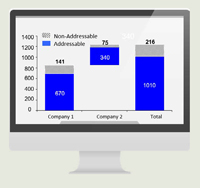
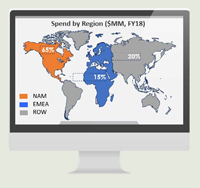
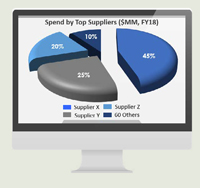

CONCLUSION
As high-value PE companies take a holistic view of operational aspects of their portfolio companies, they can create further value by turning to digital procurement technology. By deploying a unified S2P platform, they can solve the complex challenges faced by procurement in portfolio companies as they look toward the future.

